This is a list of 7 proven blog post templates.
In fact, these templates have helped my blog grow to over 522,981 unique visitors every month.
A blog post template simply shows the structure to follow when writing a blog post. Our blog post template eases your approach to writing helpful content for your target audience in a convenient and painless manner.
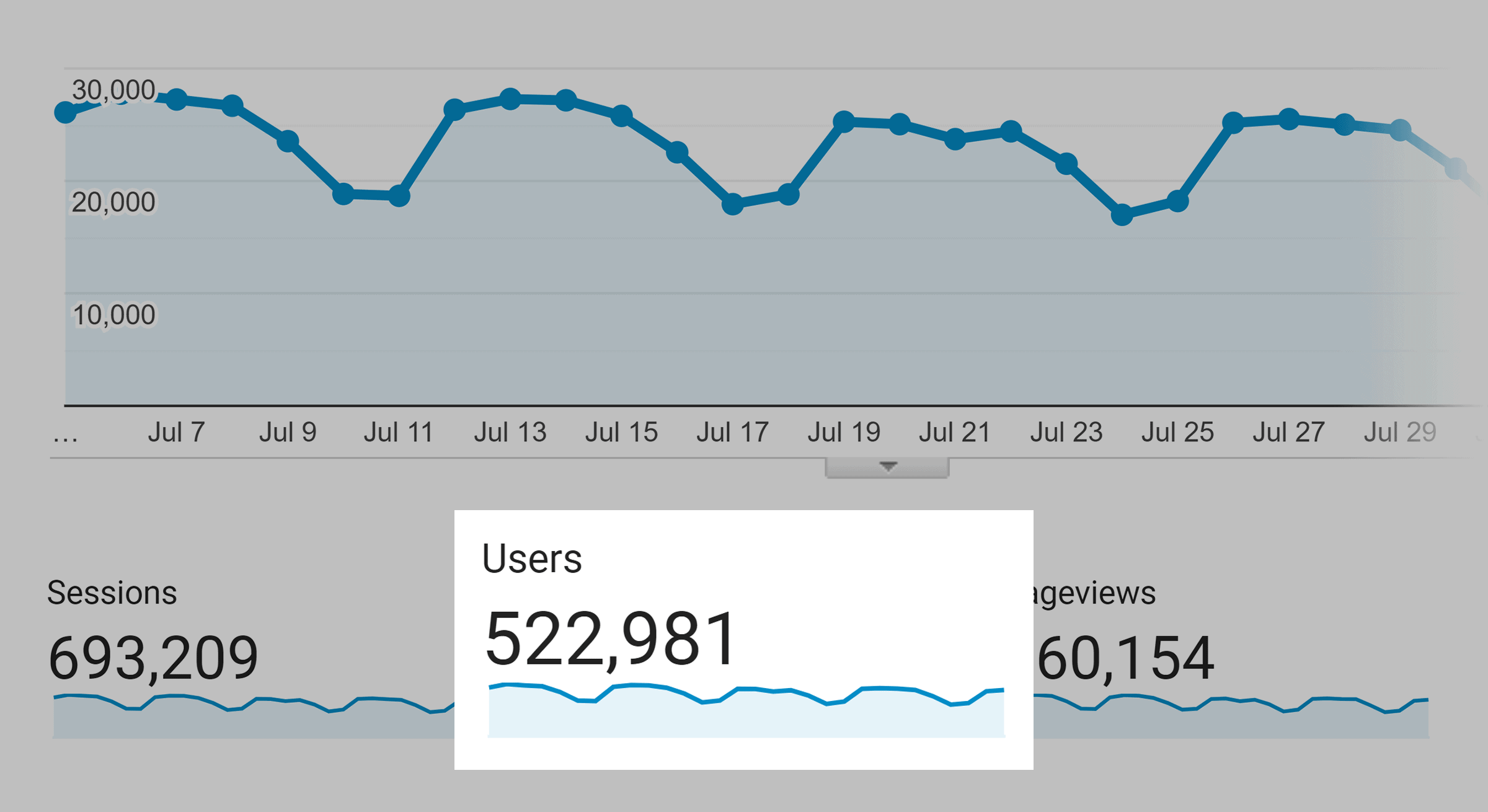
And in this guide, I’ll give you 7 super detailed content templates that are working great right now.
1. The Classic List Post
A list post (also sometimes called a “Listicle”) is a list of 10-25 bite-sized tips, strategies, techniques, tools… or anything else that makes sense for a list.
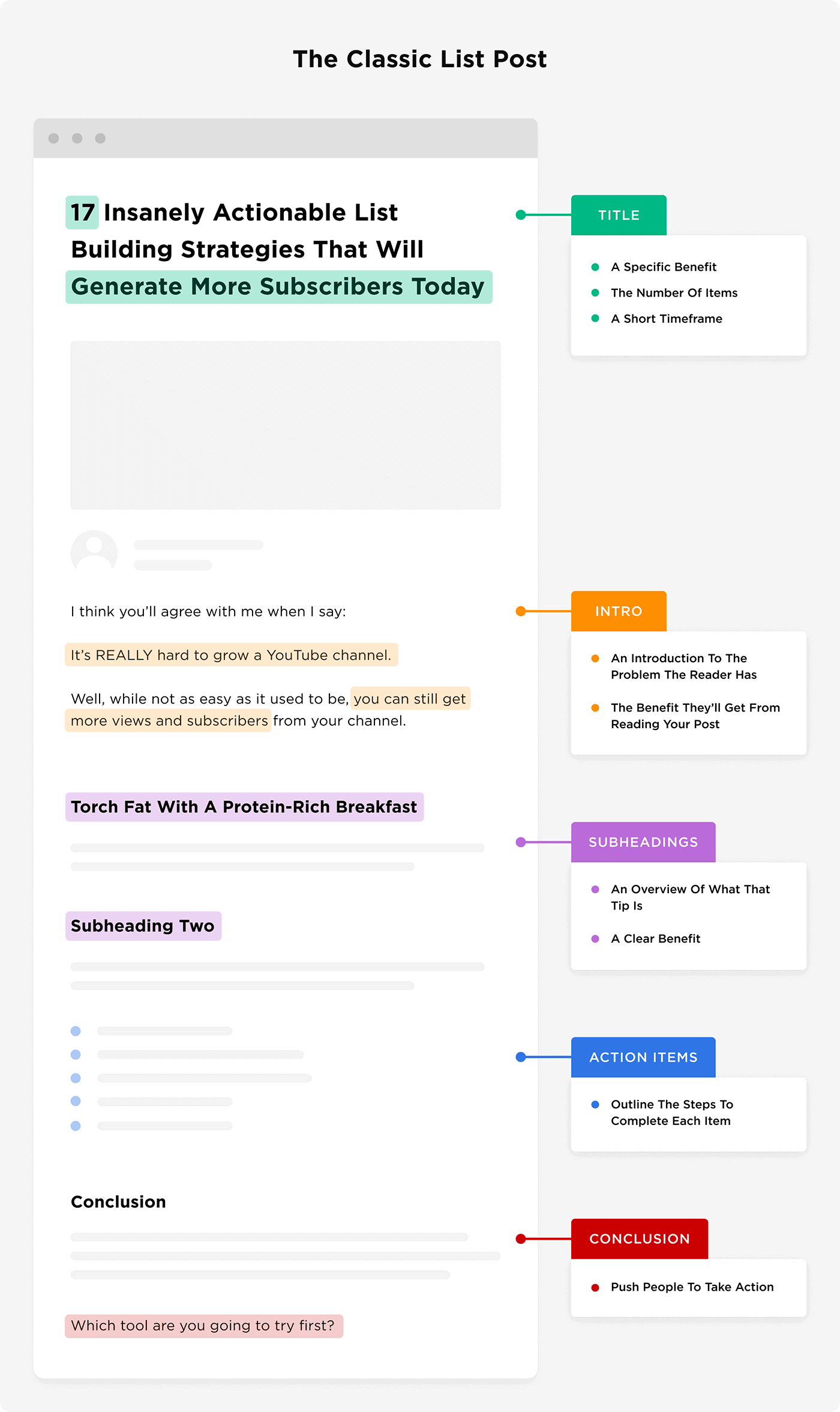
Because they distill a topic into actionable steps, list posts tend to be super search engine friendly. In fact, the post that brings us the most organic traffic every month is a list post:
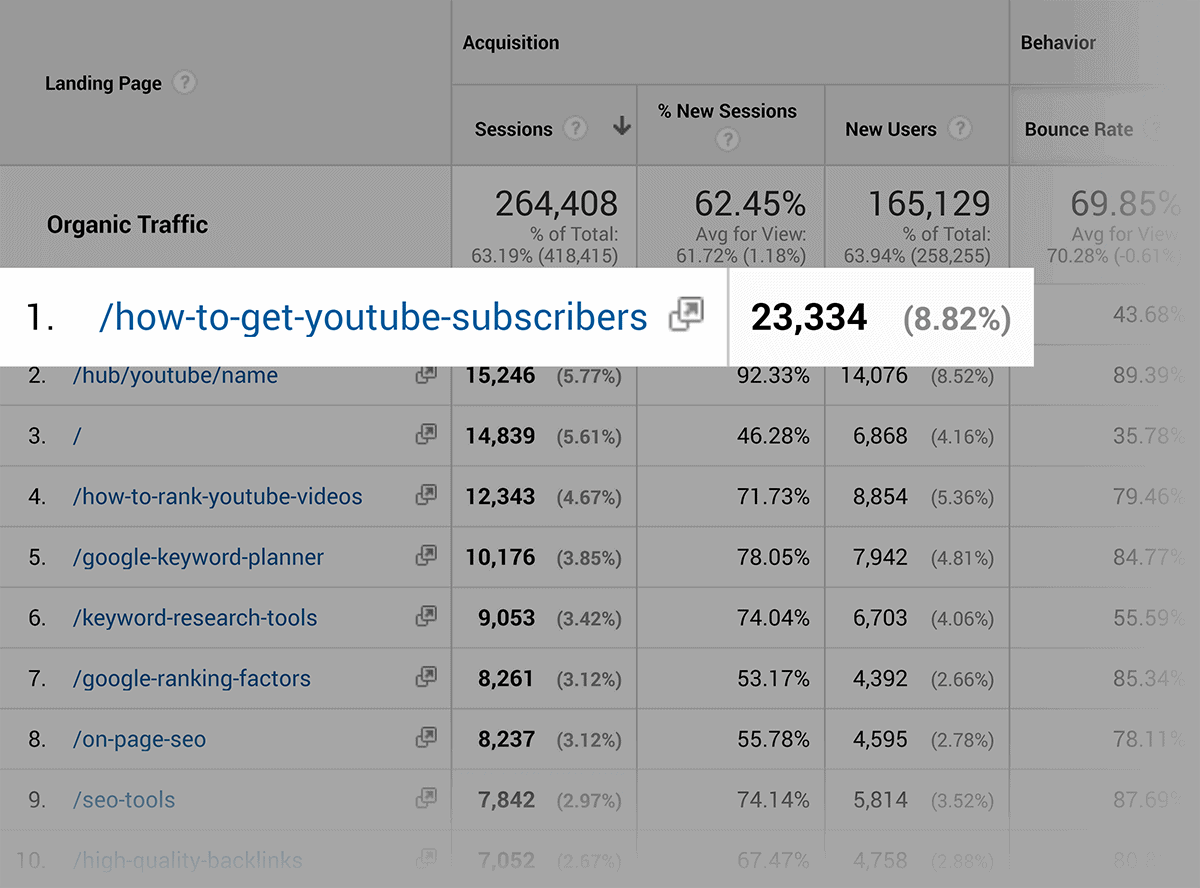
List Post Title
Your list post title needs three things:
- A benefit
- The number of items
- A short timeframe
First, you need to state the benefit that someone will get out of reading your post. There’s no need to be overly creative here. Simply name the benefit.
Example: 17 Insanely Actionable List Building Strategies That Will Generate More Subscribers Today (The benefit is: “will generate more subscribers”).
Next, you need the number of items on your list. If possible, start your title off with that number.
Example: 22 Things You Can Do Today to Change Your Photography Forever
Finally, you want to demonstrate a specific time frame that shows how actionable your content is. People love strategies they can implement right away.
Example: 24 Quick Actions You Can Do Today That Can Change Your Financial Life Forever
List Post Introduction
Your list post introduction has two parts:
- An introduction to the problem the reader has
- The benefit they’ll get from reading your post
First, you quickly (and I mean quickly) introduce the problem that the items on your list will help them solve.
Example: I think you’ll agree with me when I say:
It’s REALLY hard to grow a YouTube channel.
Second, (quickly!) introduce the benefit that your list post will help them achieve.
Good Example:
Well, while not as easy as it used to be, you can still get more views and subscribers from your channel.
Pro Tip: Don’t forget to really emphasize that your content will help solve the reader’s problem. The more clear that is, the more likely they are to read on.
List Post Subheadings
Subheadings are HUGE.
First, they break your content up into manageable chunks.
Second, when you make your subheaders benefit-rich, it boosts the perceived value of your content.
So each of your subheadings should contain two things:
- An overview of what that tip is
- A clear benefit
When people see items that will help them lose weight, eat better or make more money, they’re more likely to share it.
Good Example: Torch Fat With a Protein-Rich Breakfast.
Bad Example: Eat Protein at Breakfast
Good Example #2: Save $200/Month on Car Insurance With One Phone Call
Bad Example #2: Save Money on Car Insurance
See the difference?
Pro Tip: Make sure you start your ELP off with your best tip. This will hook people for the rest of the post.
List Post Action Items
Now it’s time to outline the steps someone will need to complete each item on the list.
Example:

Pro Tip: Include photos, screenshots, real-life examples or even video tutorials. The more visuals you include, the easier it will be for your reader to follow the steps.
List Post Conclusion
Now it’s time to wrap things up.
You want your list post conclusions to do one thing: Push people to take action.
When someone gets results from your content, they become a fan for life.
Good Example:
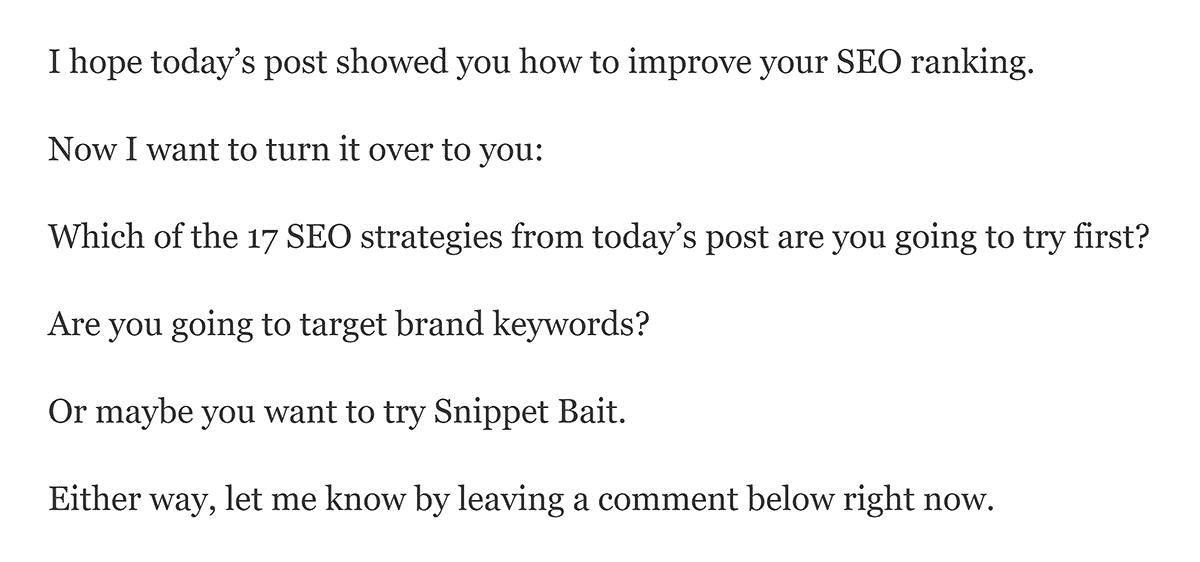
Pro Tip: Ask your reader to leave a comment. Have them publicly commit to taking action. For example, “Let me know the 1 item on this list you’re going to take action on first.”
2. The Detailed Case Study
A case study is like a traditional how-to post… backed up with a real example.
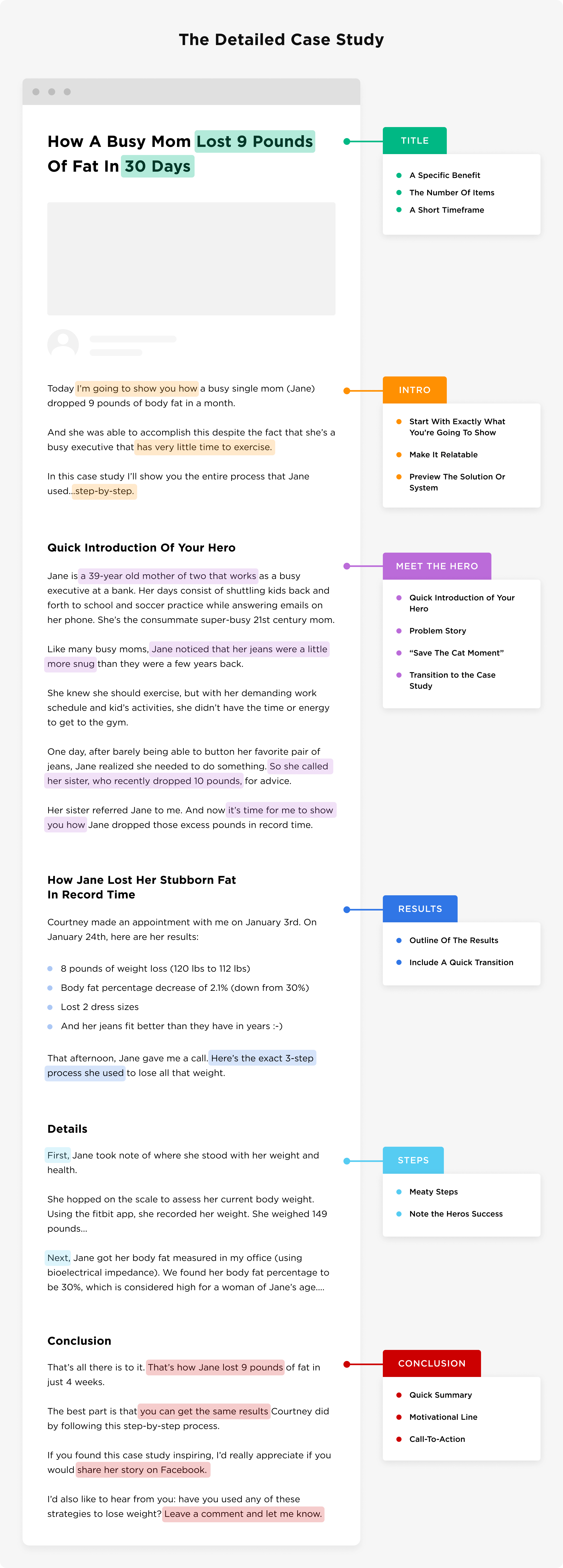
Case Study Title
To get the most clicks and attention to your case study, your headline should contain 3 elements:
Specific Benefit
First, state the benefits that the “hero” of your case study saw. The more specific, the better.
Example: “How a Busy Mom Lost 9 Pounds of Fat in 30 days”
A number
Second, you want to include at least one number. This number adds credibility to your case study by showing you have actual data behind your content.
Example: “Link Building Case Study: How I Increased My Search Traffic by 110% in 14 Days”
Timeframe
Finally, specify how long it took to see those benefits. The shorter the time frame the better.
Good Example: “From Geek to Freak: How I Gained 34 lbs. of Muscle in 4 Weeks”
Pro Tip: Don’t be afraid to write about modest results in your case study. In fact, modest results are usually BETTER than uber-impressive results. Why? Because they’re more relatable. In other words, a case study of someone losing 10 pounds is often more compelling than one that describes how someone lost 100 pounds.
Case Study Introduction
Here’s what you include in your case study introduction:
First, start your intro off with EXACTLY what you’re going to show them in the case study. As the old journalism saying goes: “Don’t bury the lead”. 🙂
Example: “Today I’m going to show you how a busy single mom (Jane) dropped 9 pounds of body fat in a month.”
Next, break down some of the things that make you, your client, friend, or customer relatable.
Example: “And she was able to accomplish this despite the fact that she’s a busy executive that has very little time to exercise.”
Finally, preview the solution or system that was used to get this benefit. Then mention you’ll outline how they did it in detail.
Example: “In this case study I’ll show you the entire process that Jane used… step-by-step.”
Meet The Hero Section
The “Meet The Hero” section is where you introduce the hero of your case study. This section is important because it helps your reader connect with your hero and put themselves in your hero’s shoes.
Quick Introduction of Your Hero
Example: “Jane is a 39-year old mother of two that works as a busy executive at a bank. Her days consist of shuttling kids back and forth to school and soccer practice while answering emails on her phone. She’s the consummate super-busy 21st-century mom.”
Problem Story
Example: “Like many busy moms, Jane noticed that her jeans were a little more snug than they were a few years back.
She knew she should exercise, but with her demanding work schedule and kid’s activities, she didn’t have the time or energy to get to the gym.”
“Save The Cat Moment”
The term “Save The Cat” comes from the screenwriting classic, Save The Cat. It’s a small detail that makes your hero more human and relatable.
Good Example: “One day, after barely being able to button her favorite pair of jeans, Jane realized she needed to do something. So she called her sister, who recently dropped 10 pounds, for advice.”
Transition to the Case Study
Good Example: “Her sister referred Jane to me. And now it’s time for me to show you how Jane dropped those excess pounds in record time.”
Results Section
At this point, your reader is anxious to see how they did it. But before diving into the steps, whet their appetite with a quick overview of your hero’s results.
Your Results Section subheading should reiterate your hero’s results.
Example: “How I Boosted My Conversion Rate by 73.4% (Without A/B Testing)”
Here’s what to include in this section:
First, quickly outline the results that your Hero achieved.
Example: “Courtney made an appointment with me on January 3rd. On January 24th, here are her results:
- 8 pounds of weight loss (120 lbs to 112 lbs)
- Body fat percentage decrease of 2.1% (down from 30%)
- Lost 2 dress sizes
- And her jeans fit better than they have in years :-)”
Next, include a quick transition to the meat of your case study. This helps the reader understand the story is over and that it’s time to get into the meat of the content.
Example: “That afternoon, Jane gave me a call. Here’s the exact 3-step process she used to lose all that weight.”
Steps Section
Now it’s time to get into the meaty details of your case study. Many case studies are big on hype and short on details.
That’s why this section is so important. The detailed steps will make your case study stand out.
And here’s where you list the steps your hero used to make progress on Step #1. No detail is too small. Don’t be afraid to tell them EXACTLY what to do.
Example: “First, Jane took note of where she stood with her weight and health.
She hopped on the scale to assess her current body weight. Using the fitbit app, she recorded her weight. She weighed 149 pounds…
Next, Jane got her body fat measured in my office (using bioelectrical impedance). We found her body fat percentage to be 30%, which is considered high for a woman of Jane’s age…”
(Note: This is a shortened example. Your final draft should add more details and images like screenshots, diagrams, and pictures)
Case Study Conclusion
Quick Summary
Example: “That’s all there is to it. That’s how Courtney lost 9 pounds of fat in just 4 weeks.
Motivational Line
Here’s where you remind the reader that they can achieve the same result.
Example: “The best part is that you can get the same results Courtney did by following this step-by-step process.”
Call-To-Action
Example: “If you found this case study inspiring, I’d really appreciate if you would share her story on Facebook.
I’d also like to hear from you: have you used any of these strategies to lose weight? Leave a comment and let me know.”
And when you finish writing your conclusion, you’re done with your case study. Great work!
3. The Product Showdown
This post is a side-by-side comparison of two competing products. Your Product Showdown provides a ton of value. That’s because you save your reader countless hours (and dollars) on a product that may not work for them.
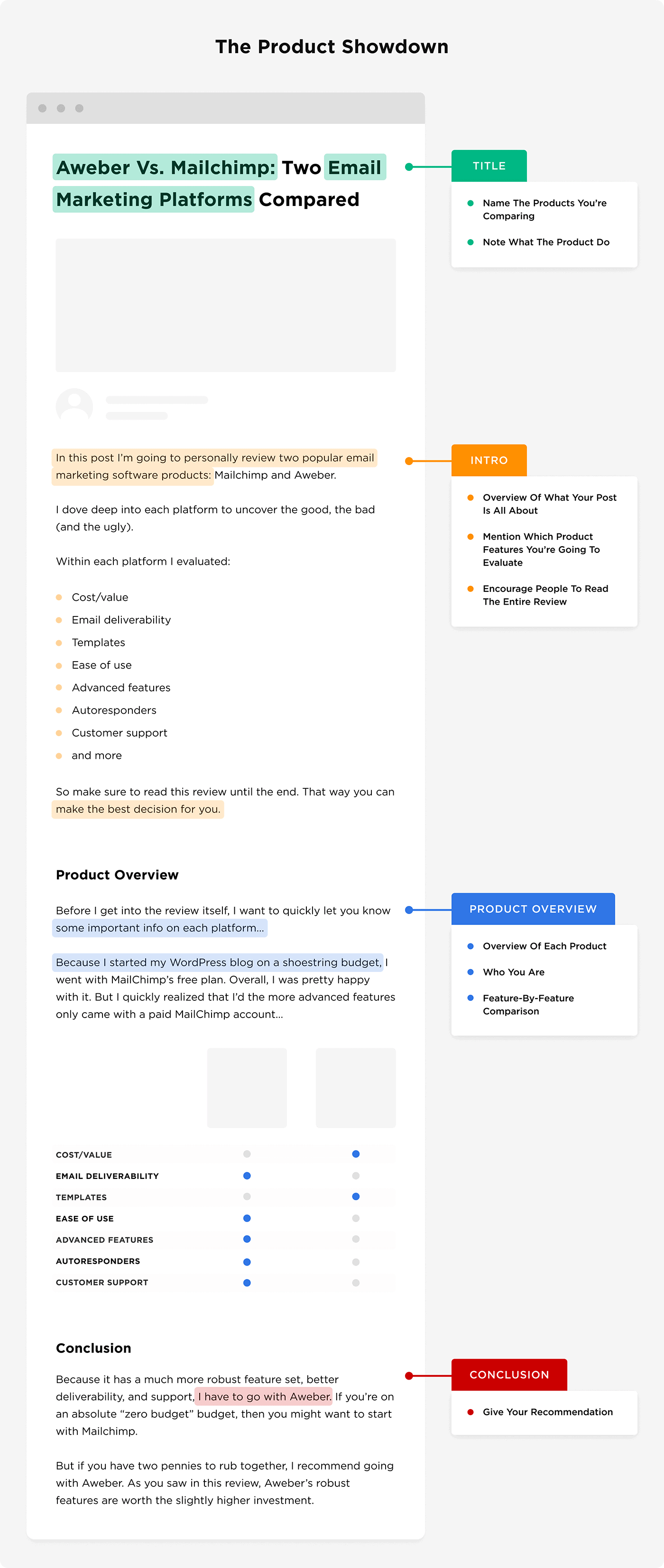
Product Showdown Title
Here are the two things to include in your Product Showdown title:
First, the two (or three) products you’re comparing
Example: “Aweber vs. Mailchimp” or “Wix vs. Squarespace”
Second, note what these products do.
In other words, their category.
Example: “Aweber vs. Mailchimp: Two Email Marketing Platforms Compared” or “GNC Fish Oil vs. Optimum Nutrition: We Tested Both Supplements”
Pro Tip: Include the name of both products in your title (for example, “Aweber vs. Mailchimp”). These “product vs. product” keywords tend to get a ton of searches in Google.
Product Showdown Intro
(Quick) overview of what your post is all about
This is straightforward: let people know which products you’re reviewing. This lets your readers know they’re in the right place.
Example: “In this post, I’m going to personally review two popular email marketing software products: Mailchimp and Aweber.”
Mention which product features you’re going to evaluate
This shows that you’re going to review the products in-depth. This is important because it demonstrates to the reader that you already did the hard work for them.
Example: “I dove deep into each platform to uncover the good, the bad (and the ugly).
Within each platform I evaluated:
- Cost/value
- Email deliverability
- Templates
- Ease of use
- Advanced features
- Autoresponders
- Customer support
- and more”
Encourage people to read the entire review
Here’s where you let your readers know that they need to read your entire review to get the whole scoop.
Example: “So make sure to read this review until the end. That way you can make the best decision for you.”
Product Overview Section
Overview of each product
Example: “Before I get into the review itself, I want to quickly let you know some important info on each platform…”
Who you are
This is important. Here’s your opportunity to show people that you have some expertise in this area. Even if you’re not an expert, you can at least tell your story of: “here’s why I tried both products”.
Example: “Because I started my WordPress blog on a shoestring budget, I went with MailChimp’s free plan. Overall, I was pretty happy with it. But I quickly realized that I’d the more advanced features only came with a paid MailChimp account…”
Feature-By-Feature Comparison
Here’s where you begin to break down each feature, one by one (and outline how the two products compare).
Example: “Who has the better email templates?” or “Which supplement has the most omega 3s?”
Pro Tip: Kick things off with the feature that your readers are most interested in. For example, if you find that your readers want to know which fish oil has the most omega 3 fats, start off with that feature.
Product Showdown Conclusion
Now it’s time to wrap things up. In many ways, this is the moment your reader has been waiting for. They’ve read the feature comparison. Now they want to know which product you recommend.
Example: “Because it has a much more robust feature set, better deliverability, and support, I have to go with Aweber. If you’re on an absolute “zero budget” budget, then you might want to start with Mailchimp.
But if you have two pennies to rub together, I recommend going with Aweber. As you saw in this review, Aweber’s robust features are worth the slightly higher investment.”
4. Things To Do After “X”
A Things To Do After “X” post gives your readers a step-by-step game plan during a critical time. For example, your reader may know how to do kettlebell swings. But what should they do after their workout? Rest? Eat? Stretch?
Your Things To Do After “X” post answers this question in detail.
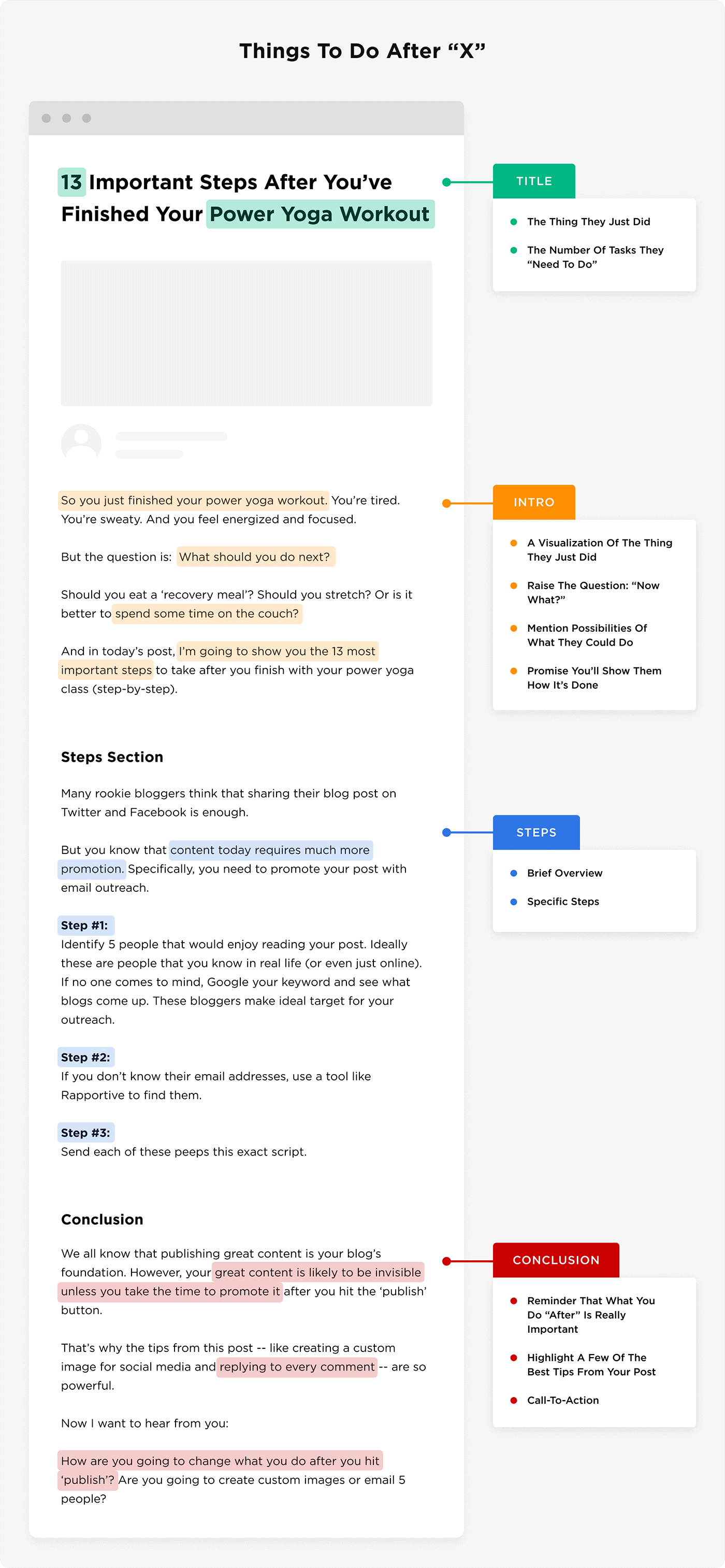
Things To Do After “X” Title
The headline for this blog post template should contain two elements:
The thing they just did
Example: “Publishing a blog post” or “Finished a power yoga class”.
The number of tasks they “need to do” when they’re done
Example: “12 Things You Need to Do After You Publish a Blog Post” or “13 Important Steps After You’ve Finished Your Power Yoga Workout”
Things To Do After “X” Introduction
Your Things To Do After “X” intro contains four elements:
A visualization of the thing they just did
Example: “So you just finished your power yoga workout. You’re tired. You’re sweaty. And you feel energized and focused.”
Raise the question: “Now what?”
Example: “But the question is: What should you do next?”
Mention possibilities of what they could do
Example: “Should you eat a ‘recovery meal’? Should you stretch? Or is it better to spend some time on the couch?”
Promise you’ll show them how it’s done
Example: “And in today’s post, I’m going to show you the 13 most important steps to take after you finish with your power yoga class (step-by-step).
Steps Section
Now it’s time to dive right into the items on your list.
And your subheader should clearly state what your reader needs to do.
Each step in your Things To Do After “X” list contains 3 elements.
Brief overview
Before you dive into the step-by-step detail, it’s time to write a quick (50-90 word) overview of each step.
This overview gives context to the item and shows people exactly why it’s important.
Example: “Many rookie bloggers think that sharing their blog post on Twitter and Facebook is enough.
But you know that content today requires much more promotion. Specifically, you need to promote your post with email outreach.”
Pro Tip: Try to write this overview in their own words. You can look at forums, Reddit and old emails to see how your readers and customers describe their problems.
Specific steps
Here’s where you list the steps your reader will need to take to complete the task.
Example:
“Step #1: Identify 5 people that would enjoy reading your post. Ideally these are people that you know in real life (or even just online). If no one comes to mind, Google your keyword and see what blogs come up. These bloggers make ideal targets for your outreach.
Step #2: If you don’t know their email addresses, use a tool like Rapportive to find them.
Step #3: Send each of these peeps this exact script:”
Things To Do After “X” Conclusion
Reminder that what you do “after” is really important
Example: “We all know that publishing great content is your blog’s foundation. However, your great content is likely to be invisible unless you take the time to promote it after you hit the ‘publish’ button.”
Highlight a few of the best tips from your post
Example: “That’s why the tips from this post — like creating a custom image for social media and replying to every comment — are so powerful.
CTA
Example: “Now I want to hear from you:
How are you going to change what you do after you hit ‘publish’? Are you going to create custom images or email 5 people?”
5. The Beginner’s Guide
The Beginner’s guide is one of my favorite blog post templates. This template helps eliminate overwhelm by showing your readers the exact first steps to get started.
In fact, because they’re so valuable, Beginner’s Guides tend to attract a ton of backlinks and social media shares.

The Beginner’s Guide Title
Your Beginner’s guide title should contain the topic you’re covering and the words “Beginner’s Guide”.
Example: “The Beginner’s Guide to Interval Training” or “Link Building: The Beginner’s Guide”.
Pro Tip: Don’t be afraid to pick a super-specific topic for your guide. People love to read guides that are “an inch wide and a mile deep”. For example, instead of “The Beginner’s Guide to Gardening” go with “The Beginner’s Guide to Growing Tomatoes”.
The Beginner’s Guide Introduction
A “promise statement”
First, hit your reader off with a “promise statement” of the benefit they’ll get from reading your guide.
Example: Today I’m going to show you how to grow a brand new blog from scratch.”
Outline how complex the topic can be
Next, show your reader that you understand how hard this topic is to learn. This will show you understand where they’re coming from.
Example: “I remember when I first started to learn about SEO. I’d go from blog post to forum thread trying to understand how SEO actually worked. It was super confusing and frustrating”
A preview of what’s to come
Finally, preview the awesomeness that’s coming up.
Example: “And in this no-nonsense guide I’ll cut out all the noise and BS and show you exactly how to start building links to your website.”
The Topic Overview
Now it’s time to explain exactly what the topic you’re covering is all about. Don’t be afraid to really dumb things down here (this is a beginner’s guide after all).
A simple definition
Example: “What is link building, exactly?”
Link building is the process of creating links from other sites to your site. It’s important because links are the #1 ranking factor that Google uses to rank websites.”
An example (or two)
Example: “For example, let’s say you have a page on your site about baking low-carb cookies. How does Google know that your page deserves to rank above the thousands of other pages on that same topic?
Backlinks. And when you build links from other related sites to your low-carb cookie page, Google will rank it higher in their search results.”
Transition to the next section
Example: “Now that you understand what link building is, it’s time for me to explain more about how to get started with it.”
Steps Section
Here’s where you walk your readers through the first few critical steps to get them on their way. These steps may not get them all the way to their goal, but they’ll point them in the right direction.
Brief overview of the step
Good Example: “Your first step with link building is actually to create something worth linking to on your own site.
Because the fact is, unless you have a piece of awesome content on your site, it’s going to be impossible to build the type of high-quality links that you need to rank in Google.”
Good Example: “Here’s exactly how to do it:
First, do a Google search for your target keyword. Keep an eye out for pieces of content that impress you. If you don’t see any great pieces of content, try a few different keywords that are similar to the one you just searched for.
Next, take a look at all of the top 10 results. Note what makes them great and worthy of a first-page ranking. Is it the fact that they use a lot of examples? Is the page well-written? Are there step-by-step processes in the content?
Also, see what types of content tend to rank for your keyword.
Are they:
- List posts
- Ultimate guides
- Case studies
- “Best of” lists
Finally, plan your piece of content based on what you found. Make sure to improve on the content that’s already ranking above you –that way your content deserves to be #1.
For example, if most of the content on Google’s first page are lists posts with 10-15 items, do 25 (or even 50). Or do 15 but add more detailed info for each item.
This takes some work, but it’s the only way to build quality backlinks today.”
Transition to next step
Good Example: “At this point you have an awesome piece of content on your site. Next, we’ll start our hunt for places that you can get links from.”
Rinse and repeat this formula for as many steps as you need for your beginner’s guide.
Beginner’s Guide Conclusion
Reminder of how helpful your guide is
Example: “Thanks to ‘Link Building: The Beginner’s Guide’, you don’t need to spend hours searching for link building information anymore. You have everything you need to get started all in one place.”
Reiterate how important your topic is
Example: “As you saw in the guide, link building can make or break your SEO efforts. Without link building, your chances of ranking in Google is almost zero. But when you build links the right way you can quickly leapfrog your competition on Google’s first page.”
CTA
Example: “Now you have everything you need to get started with link building.
Before you start on your first link, make sure to leave a quick comment to let me know what you think of ‘Link Building: The Beginner’s Guide’.
6. How They Did It Post
A “How They Did It” Post shines light on how successful people or groups achieved amazing results.
These posts are great because you reveal “the secret” behind their success –and show your reader how they can achieve similar results.
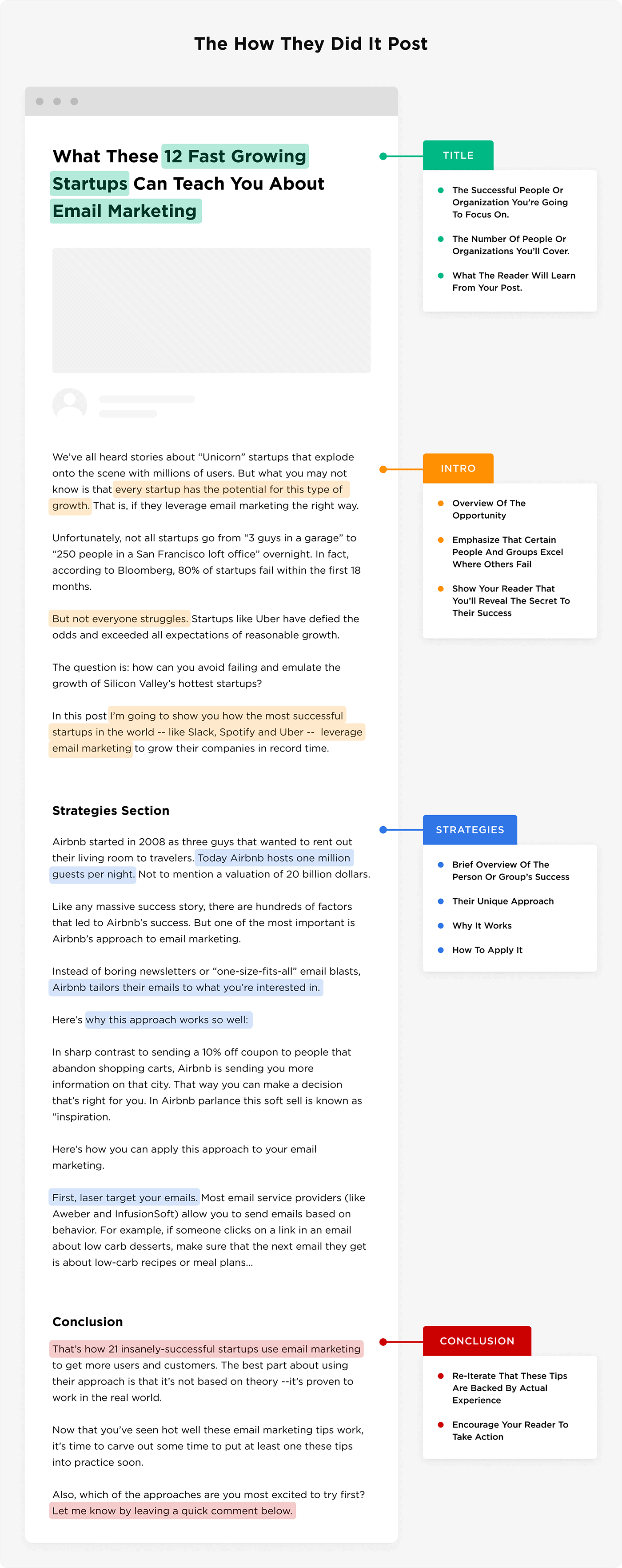
How They Did It Post Headline
Here are the three elements to include in your “How They Did It” Post headline:
The successful people or organization you’re going to focus on.
Good Example: “Fast-Growing Startups” or “World’s Most Successful Bodybuilders”
The number of people or organizations you’ll cover.
Good Example: “12 Fast-Growing Startups” or “15 of the World’s Most Successful Bodybuilders”
What the reader will learn from your post.
Good Example: “What These 12 Fast-Growing Startups Can Teach You About Email Marketing” or “15 of the World’s Most Successful Bodybuilders Reveal Their Post-Workout Regimen”.
How They Did It Post Intro
Overview of the opportunity
Here’s where you emphasize that there’s lots of opportunity for success in this area –assuming you know how to do it.
Example: “We’ve all heard stories about “Unicorn” startups that explode onto the scene with millions of users. But what you may not know is that every startup has the potential for this type of growth. That is if they leverage email marketing the right way.”
Emphasize that certain people and groups excel where others fail
This paints a clear picture that there’s a right way (and a wrong way) to approach things.
Example: “Unfortunately, not all startups go from “3 guys in a garage” to “250 people in a San Francisco loft office” overnight. In fact, according to Bloomberg, 80% of startups fail within the first 18 months.
But not everyone struggles. Startups like Uber have defied the odds and exceeded all expectations of reasonable growth.
The question is: how can you avoid failing and emulate the growth of Silicon Valley’s hottest startups?”
Show your reader that you’ll reveal the secret to their success
Finally, promise them that you’ll show them the path to success based on real-world examples.
Example: In this post I’m going to show you how the most successful startups in the world — like Slack, Spotify and Uber — leverage email marketing to grow their companies in record time.
Strategies Section
Now it’s time to outline the strategies they used to achieve their impressive results.
Brief overview of the person or group’s success
Outline a few statistics to prove this person or group is a super-successful outlier. This will motivate your reader to learn how they achieved these impressive results.
Example: “Airbnb started in 2008 as three guys that wanted to rent out their living room to travelers. Today Airbnb hosts one million guests per night. Not to mention a valuation of 20 billion dollars.”
Their unique approach
Outline what they do that’s unique or different.
Example: “Like any massive success story, there are hundreds of factors that led to Airbnb’s success. But one of the most important is Airbnb’s approach to email marketing.
Instead of boring newsletters or “one-size-fits-all” email blasts, Airbnb tailors their emails to what you’re interested in.”
Why it works
Example: “Here’s why this approach works so well:
In sharp contrast to sending a 10% off coupon to people that abandon shopping carts, Airbnb is sending you more information on that city. That way you can make a decision that’s right for you. In Airbnb parlance, this soft sell is known as “inspiration”.
How to apply it
Example: “Here’s how you can apply this approach to your email marketing.
First, laser target your emails. Most email service providers (like Aweber and InfusionSoft) allow you to send emails based on behavior. For example, if someone clicks on a link in an email about low carb desserts, make sure that the next email they get is about low-carb recipes or meal plans…”
How They Did It Post Conclusion
You’ve given your audience a ton of actionable tips based on real-world examples. Now it’s time to encourage them to take action.
Re-iterate that these tips are backed by actual experience
Remind your readers one last time that your advice is unique and battle-tested in the real world.
Example: “That’s how 21 insanely-successful startups use email marketing to get more users and customers. The best part about using their approach is that it’s not based on theory –it’s proven to work in the real world.
Encourage your reader to take action
Push the reader to use your advice and make a public commitment by leaving a comment.
Example: “Now that you’ve seen how well these email marketing tips work, it’s time to carve out some time to put at least one of these tips into practice soon.
Also, which of the approaches are you most excited to try first? Let me know by leaving a quick comment below.”
7. The Myth Debunker
Our last blog template is “The Myth Debunker”. Why does this template work so well? Two reasons: First, when you dispel common myths, you drum up controversy. Controversy pushes people that agree (and disagree) with you to share your content.
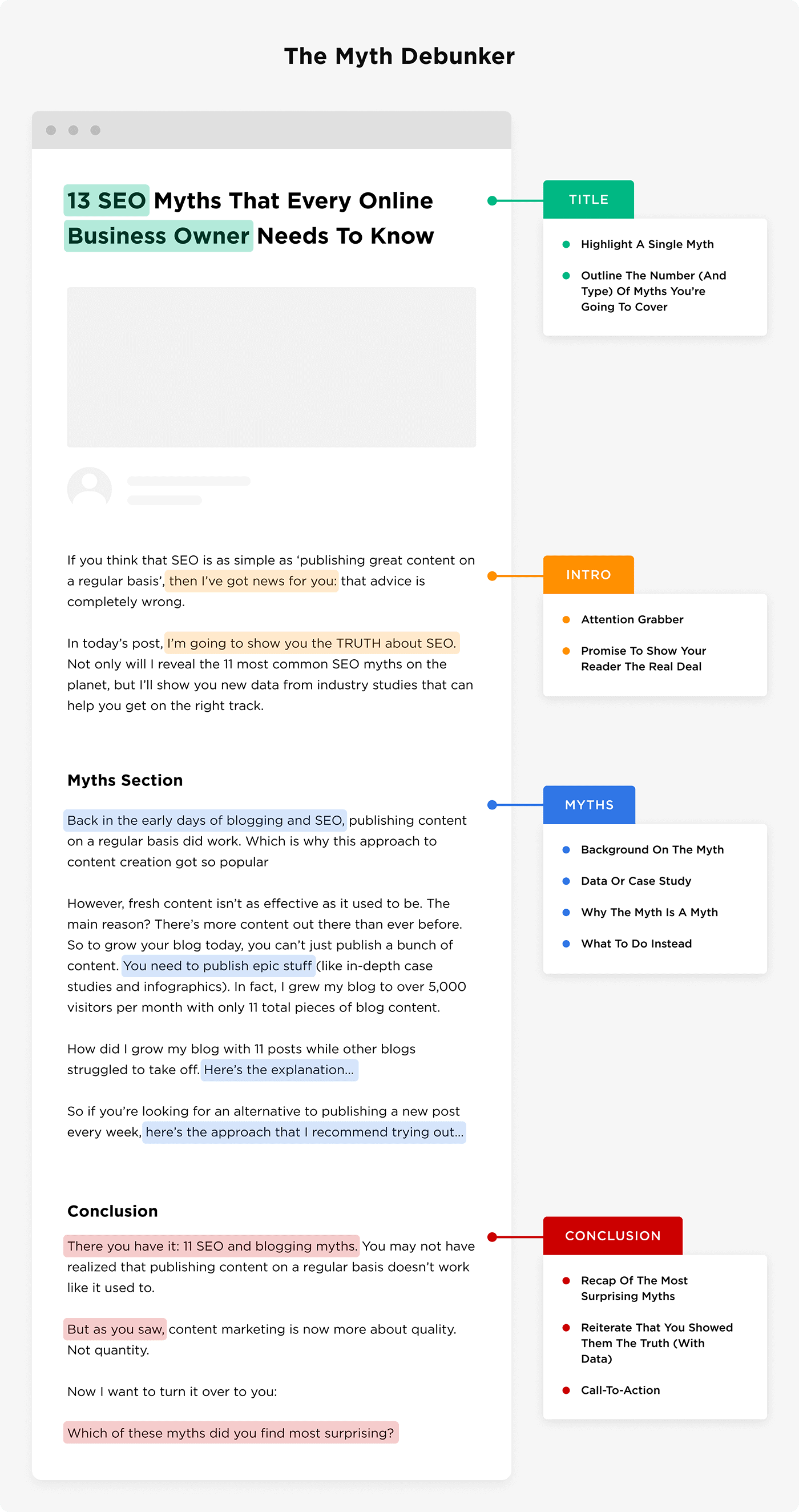
Also, when you round up a bunch of “best practices”, and prove that they’re myths, you show off your knowledge and expertise.
The Myth Debunker Title
You have two options with your Myth Debunker title:
Highlight a single myth: “The ____ Myth Debunked (Plus 5 More ____ Myths That Drive Me Nuts)”
Or
Outline the number (and type) of myths you’re going to cover: 13 ____ Myths That Every ____ Should Know
Example: “13 SEO Myths That Every Online Business Owner Needs to Know”
The Myth Debunker Intro
Like the other blog post templates we covered in this guide, the #1 goal of your Myth Debunker intro is to grab your reader’s attention. Specifically, you want to let them know they’re about to learn the truth about your topic.
Attention grabber
Your first few lines should grab your reader’s attention. Specifically, highlight one common myth in your industry.
Example: “If you think that SEO is as simple as ‘publishing great content on a regular basis, then I’ve got news for you: that advice is completely wrong.”
Pro Tip: Don’t be afraid to show some emotion here. Let your reader know that these myths really get under your skin. This will help you form an emotional bond that turns your “reader” into a “follower”.
Promise to show your reader the real deal
Preview what’s coming next. Also, highlight the fact that your post will be based on data… not hunches or opinions.
Good Example: “In today’s post, I’m going to show you the TRUTH about SEO. Not only will I reveal the 11 most common SEO myths on the planet, but I’ll show you new data from industry studies that can help you get on the right track.”
Myths Section
Here’s where you highlight (and break down) common myths in your space.
1. Background on the myth
Give your reader context on how this myth came to be.
Example: “Back in the early days of blogging and SEO, publishing content on a regular basis did work. Which is why this approach to content creation got so popular”.
2. Data or case study
Now it’s time to show your reader why this concept is a myth… and prove it with data.
Example: “However, fresh content isn’t as effective as it used to be. The main reason? There’s more content out there than ever before. So to grow your blog today, you can’t just publish a bunch of content. You need to publish epic stuff (like in-depth case studies and infographics). In fact, I grew my blog to over 5,000 visitors per month with only 11 total pieces of blog content.”
3. Why the myth is a myth
You’ve shown them the evidence. Now it’s time to explain why the myth is a myth.
Example: “How did I grow my blog with 11 posts while other blogs struggled to take off. Here’s the explanation…”
4. What to do instead
Example: “So if you’re looking for an alternative to publishing a new post every week, here’s the approach that I recommend trying out…”
The Myth Buster Conclusion
Recap of the most surprising myths
Example: “There you have it: 11 SEO and blogging myths. You may not have realized that publishing content on a regular basis doesn’t work like it used to.”
Reiterate that you showed them the truth (with data)
Example: “But as you saw, content marketing is now more about quality. Not quantity.”
Call to action
Example: “Now I want to turn it over to you:
Which of these myths did you find most surprising?”